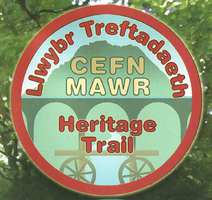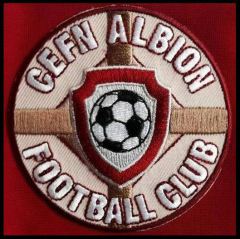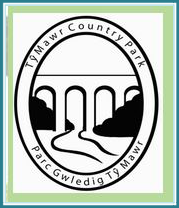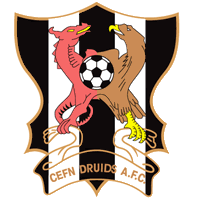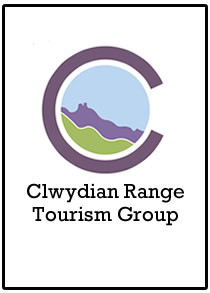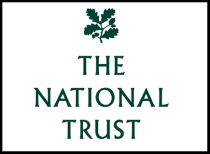Holly Bush Inn History
The Holly Bush Inn Cefn Mawr was built at the same time as the Pontcysyllte Aqueduct and is over 200 years old, read about its history from the days of Thomas Telford through to modern times and aspirations for the future.
Holly Bush Inn History.pdf
Adobe Acrobat document [5.7 MB]
The Holly Bush Inn, Well Street, Cefn Mawr, LL14 3AE, Telephone 01978 253 447 is the home of the Pas Kynaston Canal Group and office for the Plas Kynaston Canal & Railway Company.
Brief History: The present Holly Bush Inn was constructed during three different eras and represents some of the major mile stones (literally) in Cefn Mawr’s Industrial Heritage, the earliest era being that of the canals, followed by the Steam Age and then the Internal Combustion Engine and Chemical Industries.
The Canal Era: This 1792 map extract shows the canal as first planned passing through what would become Cefn Mawr on a similar elevation to Crane and Well Street today. Had the planned route of the canal, shown in red been followed, the Holly Bush Inn would have been a canal side property!
The oldest part of the Holly Bush dates back over 200 years and was built from the stone spoil produced during the construction Pontcysyllte Aqueduct. This came from the Free Stone Quarries that were cut deep into the out crop of Cape Kynaston.
This extract shows the Plas Kynaston Hall and construction of the Pontcysyllte Aqueduct, note the first stone for the Pontcysyllte Aqueduct was laid on the 25th July 1795. However plans for the canal changed and the Ellesmere Canal was terminated at the Trevor Basin. This led to head water supply problems as Tref-y-nant Brook could not deliver sufficient volume to operate the canal successfully. Therefore William Jessop drew up plans in 1803 for a branch feeder from Llangollen (red) and a Tramway (yellow) to connect local business bringing trade and water to the canal.
The Plas Kynaston Hall is a useful land mark for tracing the history of Cefn Mawr. The Plas Kynaston Hall and the Holly Bush Inn are only 50 meters apart and although the Holly Bush Inn is not always shown on the early maps, the Plas Kynaston Hall is.
Furthermore since Cefn Mawr is built on a hill this gives an indication of levels as planned for the canal in 1792, 1793, 1795 & 1796. If the canal is to the south of the Plas Kynaston Hall it is at the low level, or if to the north, at the high level. Note south is to the left of picture while North is to the right of picture. The Plas Kynaston Hall faces east.
Cutting and dressing stone blocks out of quarried stone produces spoil, and this was especially so for the construction of both the Pontcysyllte Aqueduct at the close of the 1700’s and later in the 1840’s for the construction of the Cefn Viaduct. Only the best and hardest wearing heart stone was used. Each block had to be cut and dressed accurately and the measure of this can be seen in both the aqueduct and viaduct today. The stone blocks were then packed into wagons with timbers and transported to site in the Dee Valley. Meanwhile the off cuts and softer stone spoil was put to good use in the construction of the early buildings on the Cefn Common and the Holly Bush Inn was one of those.
The accuracy of the stone work in the Pontcysyllte Aqueduct is truly amazing. We recommend not only walking over the aqueduct for the fine views along the Dee Valley but also to take the time to check out the supporting piers that align with precision.
The stone piers have withstood the test of time and the ravages of the River Dee in flood during the winter months for over 200 years. This is another considerable achievement and further testimony to the quality of stone used and skill in the construction of the aqueduct.
This extract of a map dated around 1810 shows the Holly Bush Inn & Plas Kynaston Hall at the junction of Hill Street, Well Street, Crane Street, High Street and Mount Pleasant known as Cefn Square at the centre of Cefn Mawr.
The Holly Bush Inn was built in the Telford Style, originally a square building with a hip roof. Holly Bush Corner can be seen to the left of the building which allowed the passage of a horse & cart.
This is oldest part of the building built from poor grade stone as confirmed when re-rendering during renovation work in 2014.
<< New text box >>The original roof line superimposed, on the roof of the Holly Bush, 2012.
Sandstone walling from the first addition to the Holly Bush Inn can be seen set in the surrounding brickwork under the View Point Balcony for the Cefn Viaduct. The handmade fire backed brick work is from further additions at later dates and has been restored with new lime mortar to preserve the original stone and brick work.
The Holly Bush Inn and the coming age of the Railway era, 1840 and the planned route of the Chester to Shrewsbury railway line, much as it is today. The Railway Line gave rise to the second major civil construction works at the Cefn, the Cefn Viaduct to enable the railway to cross the River Dee Valley.
The Cefn Viaduct spanning the valley and still taking rail traffic across the River Dee, this fine structure is longer and higher than the Pontcysyllte Aqueduct and yet was built in less than half the time it took for the aqueduct, which played an important part in the construction of the viaduct in the 1840’s.
A map dated 1865 shows what was originally a Butchers shop on Well Street and is now part of the Holly Bush Inn, currently referred to as “The Old Bookies” after Ken the bookmaker who was the last tenant in the 1970’s.
Built around the time of construction of the Cefn Viaduct it once had a gable end facing on to Well Street. This was lost when the roof was changed around 1900 to the present long ridge line. During renovation of this section of the Holly Bush Inn, a large part of the lower sandstone walling had to be replaced as it had been badly eroded by road splash. This indicates the difference in the quality of the stone used for buildings in comparison to that used for the construction of both the viaduct and aqueduct. They have been withstanding the flow of the river Dee for a lot longer every day and are still magnificent structures.
Sandstone was taken by railway past the Holly Bush Inn from the quarries to the Trevor Basin for shipment across the aqueduct to the opposite side of the valley for construction of the Cefn Viaduct so that it could be built from both sides.
In the 1873 Ordnance Survey edition it can be seen that another section has been added to the Holly Bush Inn. The building forms continuous oblong rather than separate buildings as in 1865. This third section is added at the start of the third era, that of the chemical industry in Cefn Mawr with Grassers Works and the beginnings of what would become petrochemical age of the internal combustion engine and all that has been derived from it.
The third infill section built of red brick, produced by local brick works dates from around 1880’s as can be seen from the Ordnance Survey publication of 1912 where the Holly Bush Inn has become joined to the butchers on Well Street.
The discovery of vast quantities of high quality Etruria Marl clay in the 19th Century coupled with local coal mining initiated the beginning of brick production on a vast scale. By the turn of the 20th Century, several factories employed approximately 2,000 people in the Ruabon, Acrefair, Cefn and Penybont areas and bricks became the choice building material for local construction. It is not known which local brick works supplied the bricks for the Holly Bush Inn but it is suspected there will have been several given the numerous additions and alterations to the building.
The most famous local brick works was JC Edwards with works at Tref-y-nant Acrefiar, Rhosllannerchrugog, and Pen-y-bont. But there were others as well, HR Bowers, Tatham, Afongoch, Dennis (probably the biggest), Kaye Hirst & Co, C Mason, Monk & Newell, Pant, Plasucha, Ponkey, Powells, Llwynenion, R&M, Ruabon Brick & Terracota Co ltd, Wynstay Colliery ltd, Wydham and Seacome. Thomas H Seacombe founded the Delph Brickworks in Acrefair in 1868. This then became the property of Henry Wyndham in 1883. After closure in 1955 it became an open cast coal and clay quarry, using the biggest mechanical excavator then to be found in Britain.
Just around what used to be the entrance Cefn Mawr’s Cocca Room three different types of brick are used in the construction.
Cocca Rooms were started by the Temperance Movement as an alternative venue to Pubs, because of their belief in the evils of drink.
The former Cocca Room becomes a useful part of the Holly Bush Inn during the restoration of the building in 2014/15.
Looking along Well Street in 1910 from Holly Bush Corner and the same scene in 2013.
Well Street 2012 and the Holly Bush Inn to the right still retains the distinctive cut away corner to allow the passage of a horse and cart. Also notice the difference in road level increase between 1910 & 2012 shown by the reduction in height of the window above the pavement.
The1960’s and Holly Bush Inn with the Cinema on the former railway line.
The Palace Cinema partly built on the track bed of the railway line beside the Holly Bush Inn. It was built and opened following on from the success of the Cinema at the George Edwards Hall. Construction was largely of corrugated iron which rather belied the comfortable interior. The steps lead down from the top of Hill Street to the booking office. Unfortunately the cinema was destroyed by fire in 1967. Today the remains of the cinema are well gone and the new Oxford Street serving the Tesco Supermarket occupies much of the site where the former cinema once stood.
The neighbour of the Holly Bush Inn is the George Edwards Hall, it was built in memory of George Edwards in 1911. Unfortunately it struggled as a theatre to meet overheads until 1919 when JS Jones took it over and opened the first cinema in Cefn Mawr.
This was a success. The Cefn Chronicle adversities the first film shown as “Heart of the Lion” which was followed a week later by “Crystal Gazer”. However in the 1950’s the cinema was closed and the hall went back to its original purpose as a theatre, being used for concerts and pantomimes. In 2014 the basement Waterloo Rooms were let out to the Cefn Historical Society for running a small community museum with the main hall being run by the Cefn Community Council.
The Holly Bush Inn and the George Edwards Hall at the centre of Cefn Mawr in 2006 the arrival of the Tesco Supermarket. Note the green field below the Holly Bush Inn where the new Oxford Street is laid serving Tesco and bypassing Cefn Mawr.
The Holly Bush Inn came within the boundary of the Cefn Mawr Conservation Area as designated in 2004. This map also shows the Cefn Druids football ground before it was moved to the Rock Park in 2011. Cefn Druids is the oldest football club in Wales.
This aerial photograph is from 2009 and shows Cefn Druids Football Ground in relation to the Plas Kynaston Hall, the George Edwards Hall and the Holly Bush Inn.
I n 2010 the Holly Bush had been painted red and white to try and tidy it up but the building had significant problems and would require an extensive renovation program to restore it to its former self as a leading pub in the Cefn. Even in this picture the rainwater down spout is missing and one of the upstairs windows has been board for years.
2011 and the new Tesco Supermarket is under construction on what was formerly Cefn Druids Football Ground. The new road serving it (Oxford Street) had significant effect on the commercial viability and future of the traditional shopping centre of Cefn Mawr, Well Street and Crane Street which the new road bypasses.
Tesco under construction in 2011 and the Holly Bush Inn for sale in 2012.
The brewery decided to sell off the pub after years declining sales. In 2012 pubs were closing at a rate of one a week as a national average. Despite this, the PKC Group though it may be worth while trying to save the oldest pub in the Cefn. So they approached the brewery to see what could be done. The pub occupied a prominent position at what would become the primary gateway into Cefn Mawr. Therefore if it could be kept open on a viable basis, and restored appropriately it could have positive effect on future commercial viability of Cefn Mawr as a whole. What had once been the back of the pub would become the front. This was to attract custom back onto Well Street and Crane Street, the traditional shopping centre, as well as the pub, from the new Oxford Street that served the Tesco Supermarket and bypassed the village centre of Cefn Mawr. The future of the Holly Bush & Cefn Mawr was in the balance.
Cefn Mawr and the Holly Bush Inn with the new Oxford Street to Tesco by passing Cefn Mawr which significantly reduced traffic in the village centre.
Unfortunately the conveyance did not go smoothly and the lowest point in the 200 year history of the Holly Bush Inn came during the winter of 2013.
During the conveyance the brewery forced the closure of the pub by boarding it up in breach of contract. Their financial backers Anglo Irish Bank went into administration in February 2013 when they were supposed to complete the conveyance and transfer licence agreements. However rather than do this they removed our staff and boarded the pub up in steel sheeting. The on top of that Cefn Mawr experienced the heaviest snow fall it had seen since 1982.
As far as we know this was the first time the pub had closed in over 200 years and we were not happy. The PKC Group worked very hard with their solicitors and the administrators for the brewery and we eventually got the pub reopened on the 27th March 2013. However due to the heavy snow fall it was another 2 weeks before the firm that had steeled the pub up, came back to remove the shuttering and give us our windows and doors back.
The new road layout showing Oxford Road serving the Tesco Supermarket at Cefn Mawr and the position of the Holly Bush Inn in relation to the altered (2011) main traffic through fare. Parking areas are indicated because to be able to encourage footfall into Cefn Mawr from the wider area, provision for parking will also have to be available for people visiting our village. Cars currently form the main means of transport however………
One of the PKC Group’s visions for the future is a Railway Station between the Tesco Supermarket car park and the Rhosymdere Industrial Estate. £44 million pounds was spent on the Chester to Shrewsbury line in (2014&2015) upgrading to increase service frequency. National Rail Passenger figures are higher than at any time in the history of the railways, and are increasing at the rate of 5% annually.
So this is not an unreasonable idea, please see the LDP2 pages of our website and relevant documents contained there for a very good business case. The future for our village could be bright, if we work at it.
The Holly Bush Inn Project:
The foremost point for the PKC Group with the Holly Bush project is to keep the pub open on a commercially viable basis as opposed to the trend of pub closure thought the UK, and hopefully encourage foot fall back onto Cefn Mawr high street (Well Street and Crane Street) from the new TESCO bypass of the village.
The majority of small traders in Cefn Mawr on Well Street and Crane Street have reported a down turn in business since the opening of the new Tesco store and the bypass of Cefn Mawr in 2012. This is in direct contrast to the figures reported for Tesco who are seeing a far greater number than expected. Therefore when the Holly Bush was put for sale by Pubfolio Limited it was decided to acquire the premises to try and help rectify the situation.
The property lies in a unique location occupying a most prominent position at perhaps the most important gate way into Cefn Mawr, the junction of Hill Street, Well Street, Crane Street, High Street, Mount Pleasant and the new Tesco road Oxford Street.
Therefore the main objective of the PKC Group is to raise the profile of the Holly Bush Inn and the Village as a whole by improving the presentation. This required a significant amount of work and is the subject of another short story in three parts, The Renovation of the Holly Bush Inn, parts 1,2&3. The building and restoration program for the Holly Bush Inn was planned to co-ordinate with existing business as far as possible. Disruption to neighbouring business was be strictly minimized because the restoration of the Holly Bush Inn had to provide a positive input to the local economy and not detract from it while keeping the pub open for our regulars and the community of Cefn.
Want to help out?
That’s easy, come and have a beer with us.
The Holly Bush Inn, Well Street, Cefn Mawr, Cefn, Pontcysyllte World Heritage Site, North East Wales, LL14 3AE.
Telephone 01978 253 447.
If you have any more photographs of the pub could you please let us have copies?
Regards,
PKC Group 2015.


